Main menu
Common skin conditions

NEWS
Join DermNet PRO
Read more
Quick links
Author: Dr Ahmed Sadek, Cairo Hospital for Dermatology & Venereology (Al-Haud Al-Marsoud), Egypt. March 2022.
Contributors: Dr Dalia Hossam, Dr Radwa Magdy, Dr Nehal Saied, Dr Noha Hashem, Dr Safaa Yehia Negm, Dr Moshera Saied El Bahrawy, Dr Amira Ragab, Dr Amal Wagih, Dr Haidy El-Hussieny, Dr Mona Ragib, Dr Hala Amer. Copy edited by Gus Mitchell. March 2022
Introduction
Introduction
Value of trichoscopy
Perifollicular skin
The dermatoscope is a non-invasive diagnostic device that allows better recognition of morphologic structures not visible to the naked eye. Current use of the dermatoscope has widened, and the vast majority of dermatologists and some general practitioners have embraced dermoscopy as the gold standard to differentiate melanoma from other pigmented skin lesions.
Dermoscopy has become valuable in the recognition of non-pigmented skin lesions, as well as inflammatory dermatoses, and trichoscopy is being adopted as a valuable technique in evaluating the hair not only on the scalp but on the brows and hairy areas elsewhere.
Other DermNet pages on trichoscopy include:
Trichoscopy involves examination of the scalp and hair using a handheld or a videodermoscopy device. Examination with a dermatoscope (trichoscope) can reassure patients that they have received a thorough scalp examination and provide the clinician with invaluable in vivo information about scalp and hair shaft pathology.

A conventional dermatoscope in use for trichoscopy
Videodermoscopy is a new and valuable tool in assessing hair and scalp disorders. Surface and subsurface microscopic views provide a previously unrecognized clinical perspective on disease, features seen with the naked eye are visibly enhanced, and patterns of disease that help in diagnosis are readily visualized.
The images are acquired by computerized polarized-light videomicroscopy using lenses with factors of magnification at 10× increments. Both epiluminescent and non-epiluminescent modes were employed. Alcohol gel is used as the interface solution. Captured images are digitalised and displayed on a high-resolution monitor in real-time. Selected images can be stored on a computer for serial assessment over time.
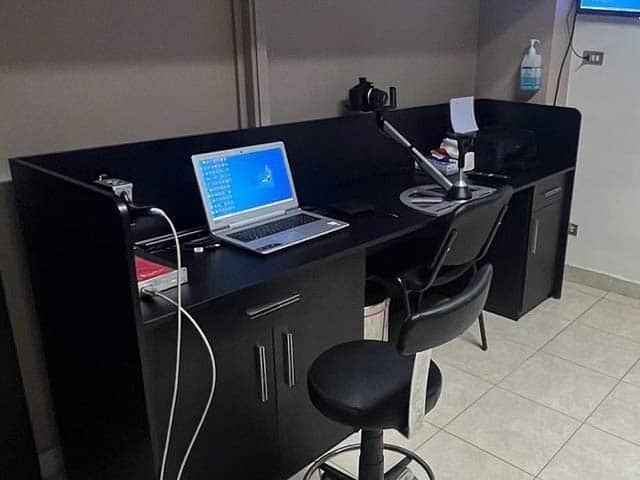
Videotrichoscopy apparatus
Trichoscopy represents a valuable, non-invasive and low-cost technique which can be of help in diagnosis of most hair and scalp diseases, allowing visualisation of the hair and scalp at x20 to x160 magnifications.
Images can be recorded digitally either using a separate digital camera connected to the trichoscope, or a built-in digital imaging system.
It can help to distinguish scarring versus non-scarring alopecia, early androgenetic alopecia versus telogen effluvium, and predict prognosis of alopecia areata.
Many studies describe its application in randomly selected patients suffering from hair loss, not only as a diagnostic tool but also in monitoring treatment response. Other uses include guiding selection of the optimum site of scalp biopsy and teledermoscopy for case discussion and second opinions.
Current research is focusing on trichoscopy of:
Trichoscopy allows four basic structures to be recognized:
All structures must be examined thoroughly and any report should include the normal and the abnormal findings as the collective data interpretation leads to a more accurate diagnosis.
Trichoscopy is a useful tool in assessment of the hair follicle condition whether:
Follicular openings are classified according to the following criteria.
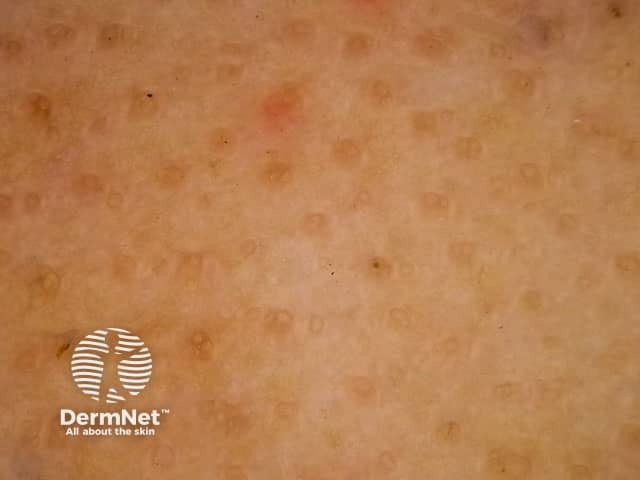
Dermoscopic image of noncicatricial alopecia areata presenting with small, uniform, regularly distributed follicular yellow dots
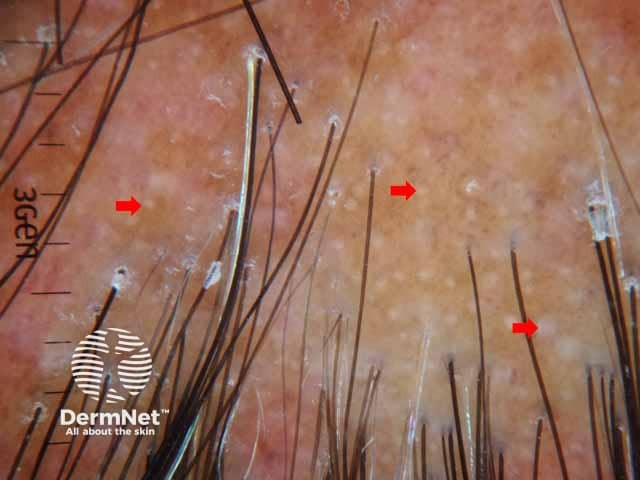
Dermoscopic image of lichen planopilaris presenting with irregularly distributed follicular openings (red arrows) denoting scarring (cicatricial) alopecia
A black dot (previously called a cadaverized hair) is a term used to describe a follicular opening which contains remnants of pigmented hairs broken at the scalp level.
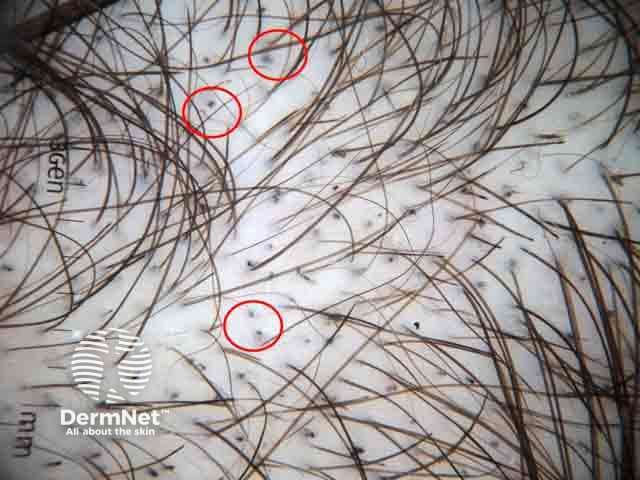
Trichotillomania showing black dots; follicular openings with remnants of pigmented hairs broken at scalp level
Yellow dots represent follicular infundibulae filled with keratin with no hair shafts. They are detected in different cicatricial and non-cicatricial disorders.
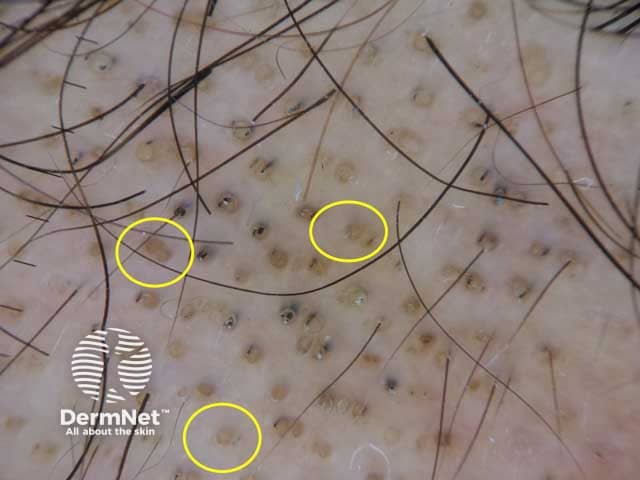
Dermoscopic image of alopecia areata showing yellow dots; follicular infundibulae are filled with keratinous material with no hair shafts. Black dots are also presented. (AA-patient2)
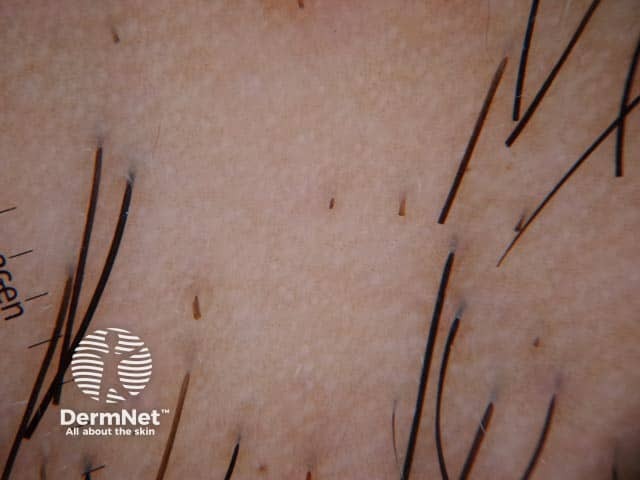
Dermoscopic image of a patient with dark skin phototype showing honeycomb pattern; white-coloured follicular opening with reticular background.
Fibrosis following the destruction of hair follicles, such as in lichen planopilaris, appears variable in size and shape and may become confluent forming structureless white areas. In severe alopecia areata, cumulus-like white dots representing confluent fibrosis of follicles are reported.
Red dots were described mainly in discoid lupus erythematosus. Many authors believe that the presence of red dots is a good prognostic factor denoting the possibility of hair regrowth.
Pink dots are occasionally seen in the eyebrow area in patients with frontal fibrosing alopecia.
The normal human hair shaft cross-section is divided into three zones; the medulla, the cortex, and the cuticle, with different variations among races.
The normal hair shafts are uniform in thickness and colour. Using trichoscopy of normal hair shafts, authors describe two types of hair:
Trichoscopy is used widely to detect different hair shaft, shape, and thickness disorders and diagnosis of their causative diseases. Abnormalities of shape can be classified according to the underlying cause:
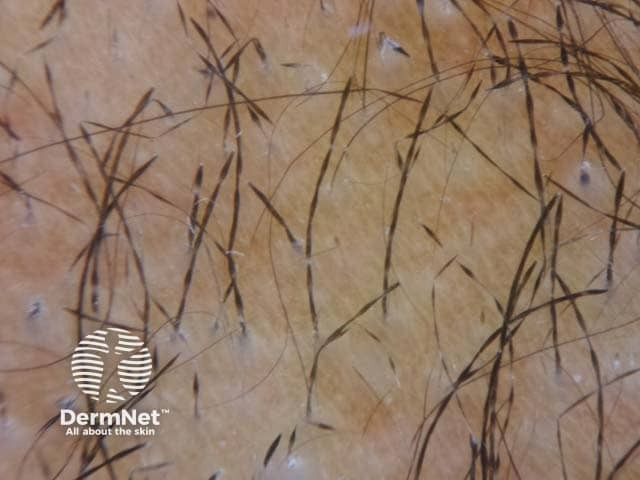
Dermoscopic image of monilethrix; regularly distributed nodes and internodes along the hair shafts

Dermoscopic image of trichoptilosis; distal splitting and damage of the hair shaft and extravasated blood in a patient with lichen simplex chronicus.
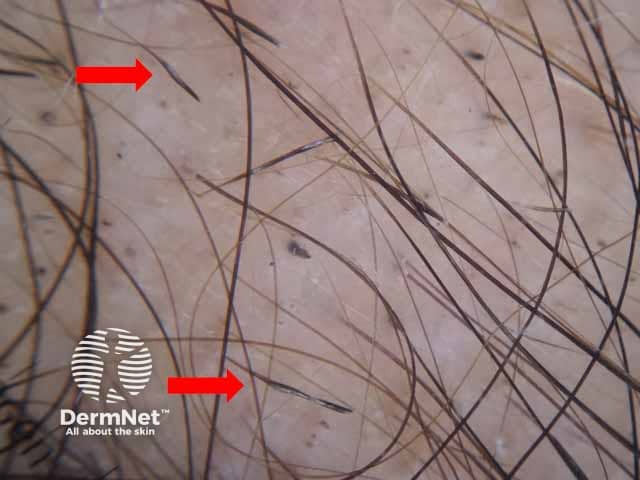
Dermoscopic image of long standing alopecia areata showing Pohl-Pinkus constriction; irregular fusiform narrowings of the hair shaft
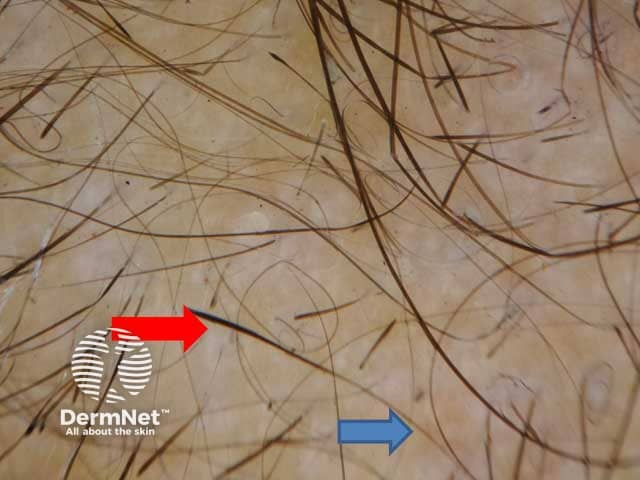
Thinning of the hair shaft at the proximal end (blue arrow) with normal thickness at the distal end (red arrow)
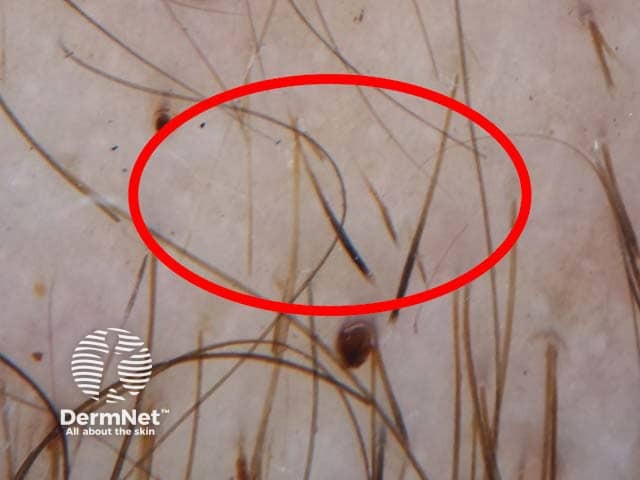
Dermoscopic image of alopecia areata presenting with exclamation mark hairs
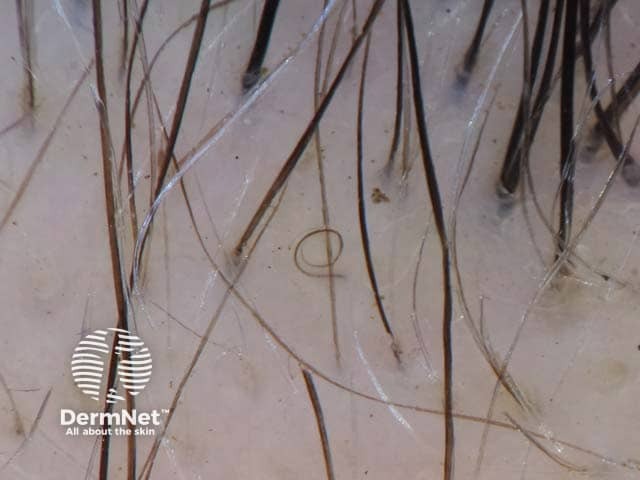
Dermoscopic image of alopecia areata showing a pigtail hair: short twisted hair representing a regrowing hair
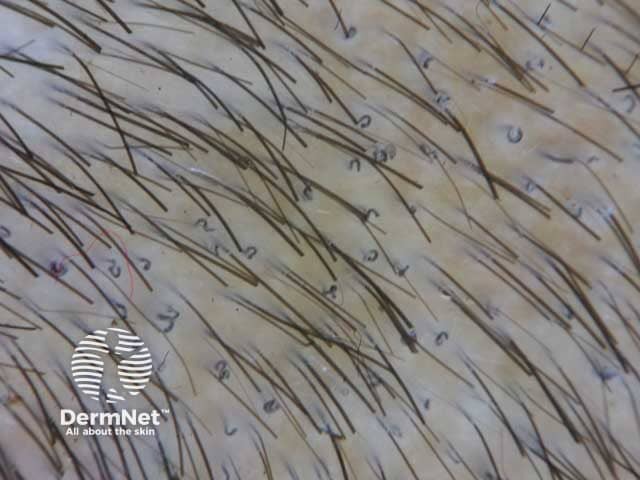
Dermoscopic image of tinea capitis presenting with comma hairs
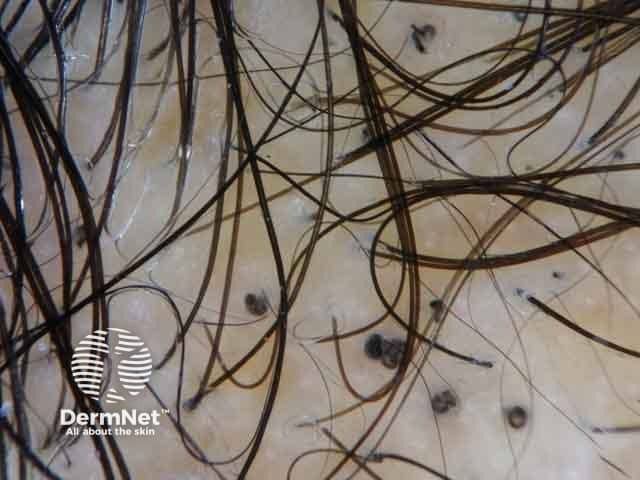
Dermoscopic image of tinea capitis presenting with corkscrew hairs
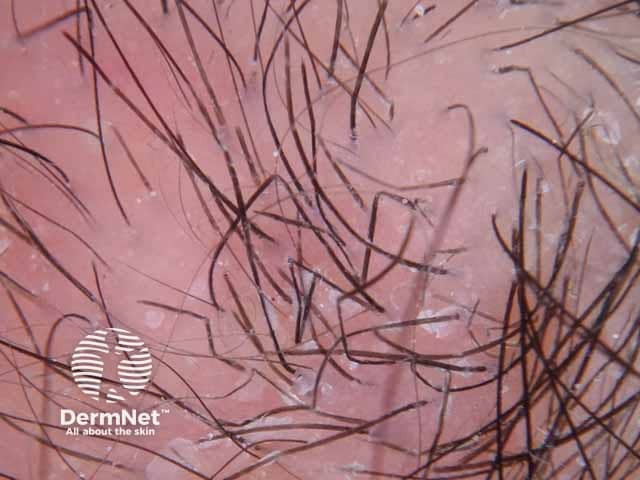
Dermoscopic image of tinea capitis showing zigzag hairs; focal weakening of the hair shaft in a male child
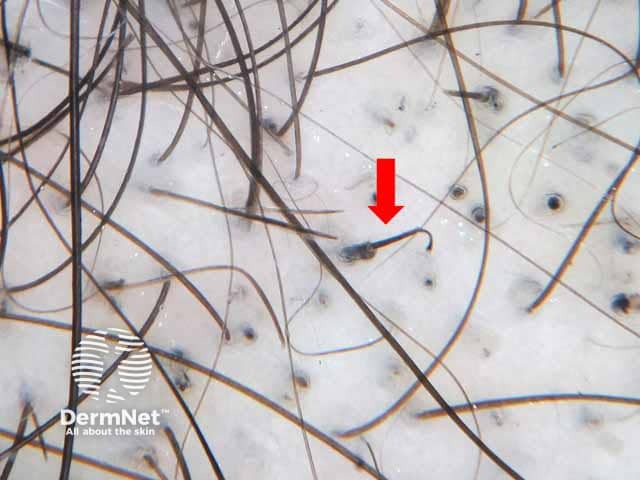
Trichotillomania showing hook hair (red arrow)
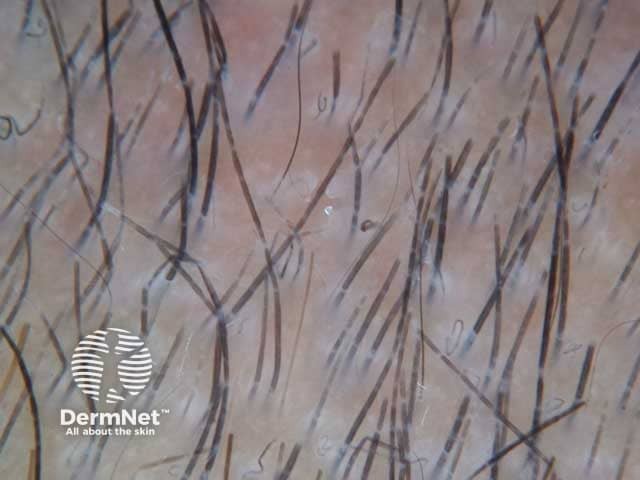
Dermoscopic image of tinea capitis showing morse code–like hair; interrupted hairs with multiple bands along the hair shaft in a female child.
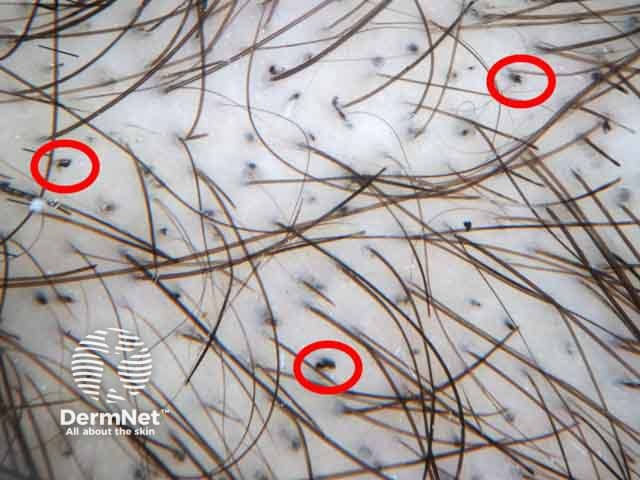
Dermoscopic image of trichotillomania showing flame figures; hair remnants of recently pulled hairs
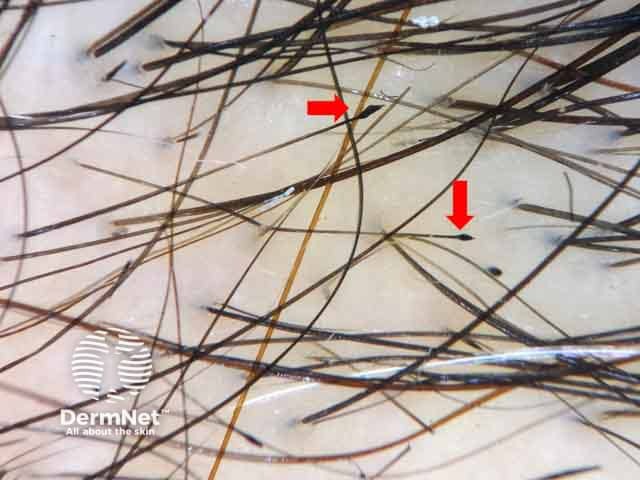
Dermoscopic image of trichotillomania showing tulip hair; hair shaft with darker distal end
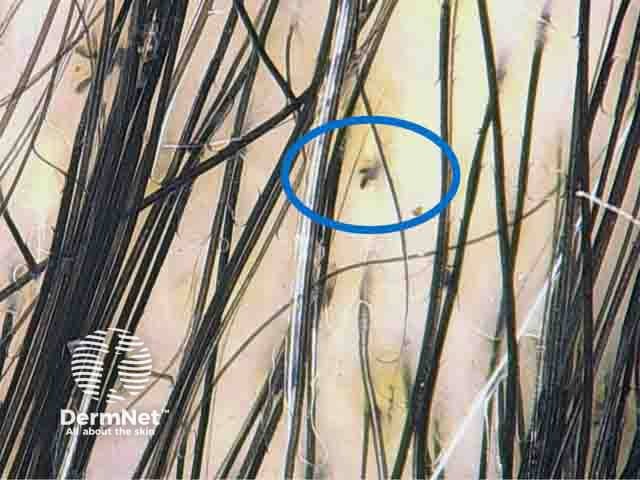
Trichotillomania showing V-sign that represents two hair shafts emerging from the same follicle and cut at the same level
Abnormalities in hair shaft thickness occur in androgenic alopecia due to miniaturization.
Hair casts represent detached hyperkeratotic and parakeratotic cells of the inner root sheath which surrounds the hair shaft. Different conditions show peritubular casts including:
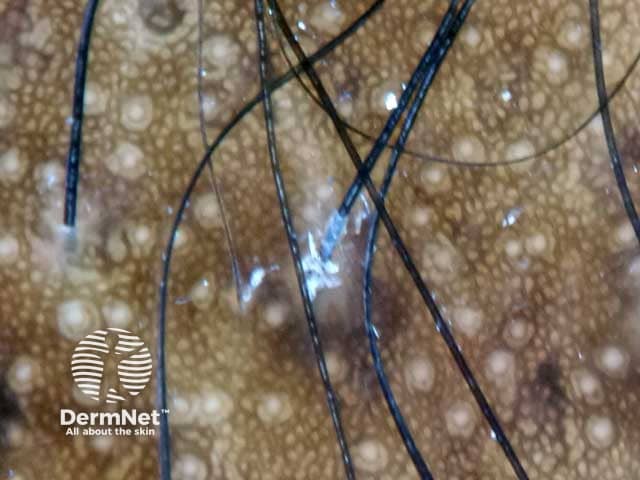
Dermoscopic image of hair cast represented by detached hyperkeratotic and parakeratotic cells of the inner root sheath
Examination of perifollicular skin provides significant clues that help in the diagnosis of different scalp disorders. Assessment of scalp texture is helpful to differentiate cicatricial from non-cicatricial alopecias.
Trichoscopic features that may be observed in perifollicular skin include; scales, areas of different colours, discharge, vascular structures, and some others.
Scalp atrophy is a clinical finding that can be confirmed using trichoscopy. In patients with alopecia areata who have received prolonged use of steroid injections, prominent vessels, and visible hair bulbs with ivory-coloured areas (due to the steroid solution excipients) are observed.
Scales are classified according to their distribution into:
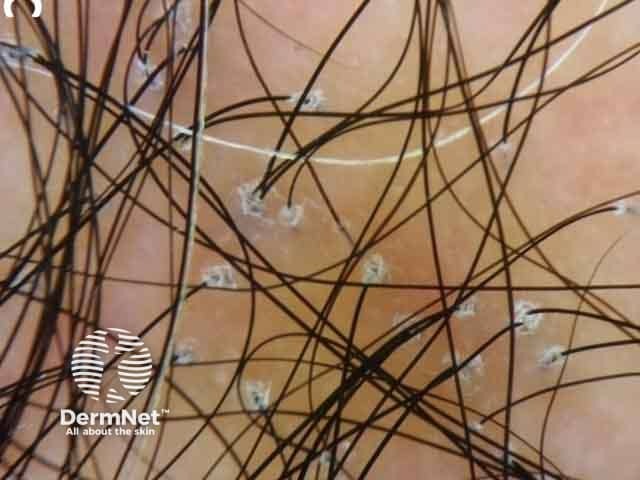
Dermoscopic image of a scaly scalp showing perifollicular scales in a female patient with lichen planopilaris
Perifollicular skin may show different colours, each suggesting an underlying specific condition.
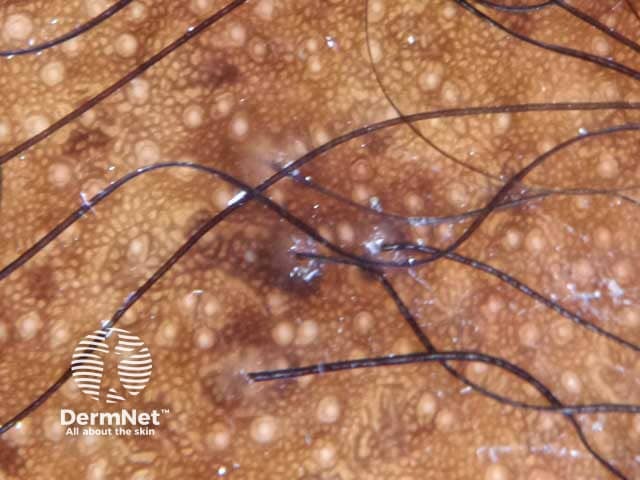
Dermosocpic image of a honey comb pattern in a female of African ethnicity
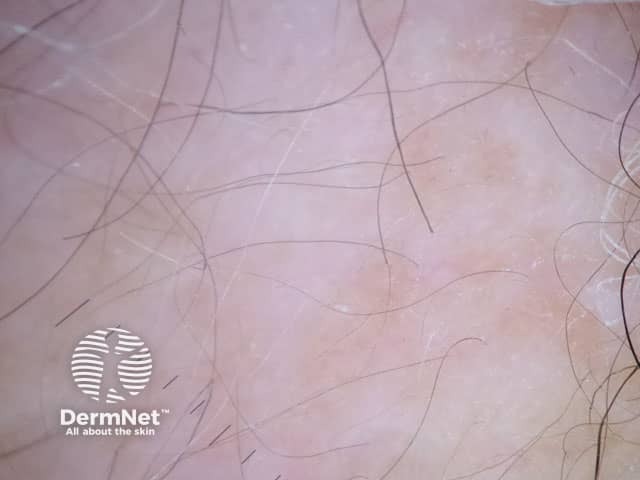
Dermoscopic image of the scalp on a female patient with longstanding alopecia areata showing white areas denoting fibrosis
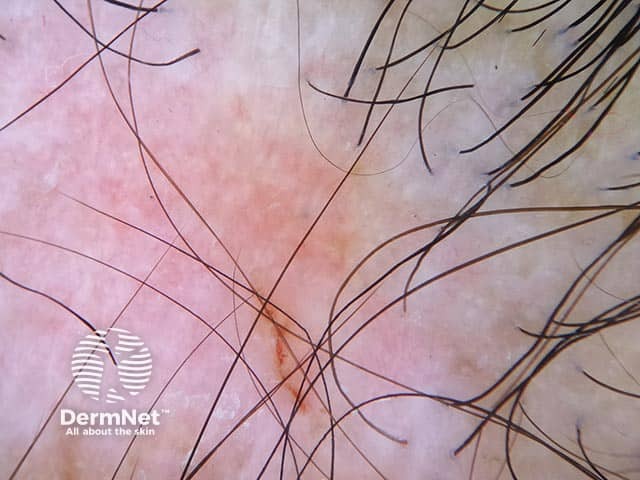
Scarring alopecia with loss of follicular openings, sclerosis and telangiectatic vessels due to discoid lupus erythematosus
Yellow and yellow-red discharge is observed in folliculitis decalvans, bacterial infections, dissecting cellulitis, or inflammatory tinea capitis.
In order to examine vascular structures of the scalp, non-contact or videodermoscopy with higher magnification is preferred. Vascular structures detected using trichoscopy are widely variable in morphology and distribution according to the underlying causative disorder.
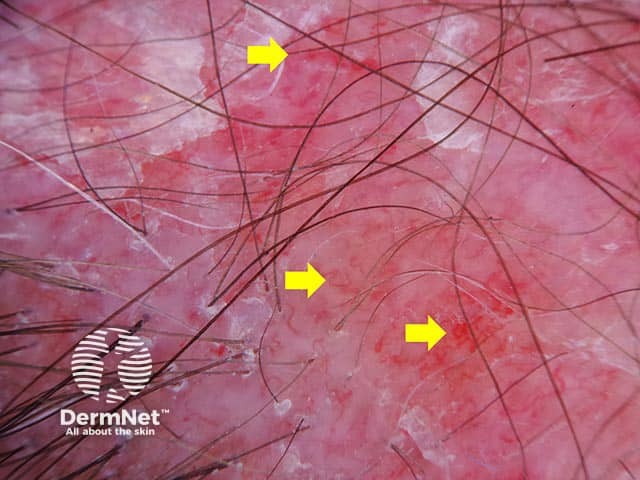
Dermoscopic image of discoid lupus erythematosus showing arborizing blood vessels (yellow arrows)
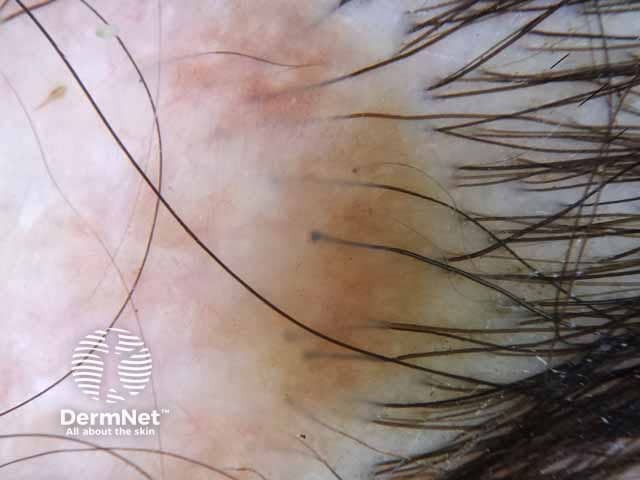
Dermoscopic image of aplasia cutis congenita showing visible hair bulbs on the scalp of a female child.